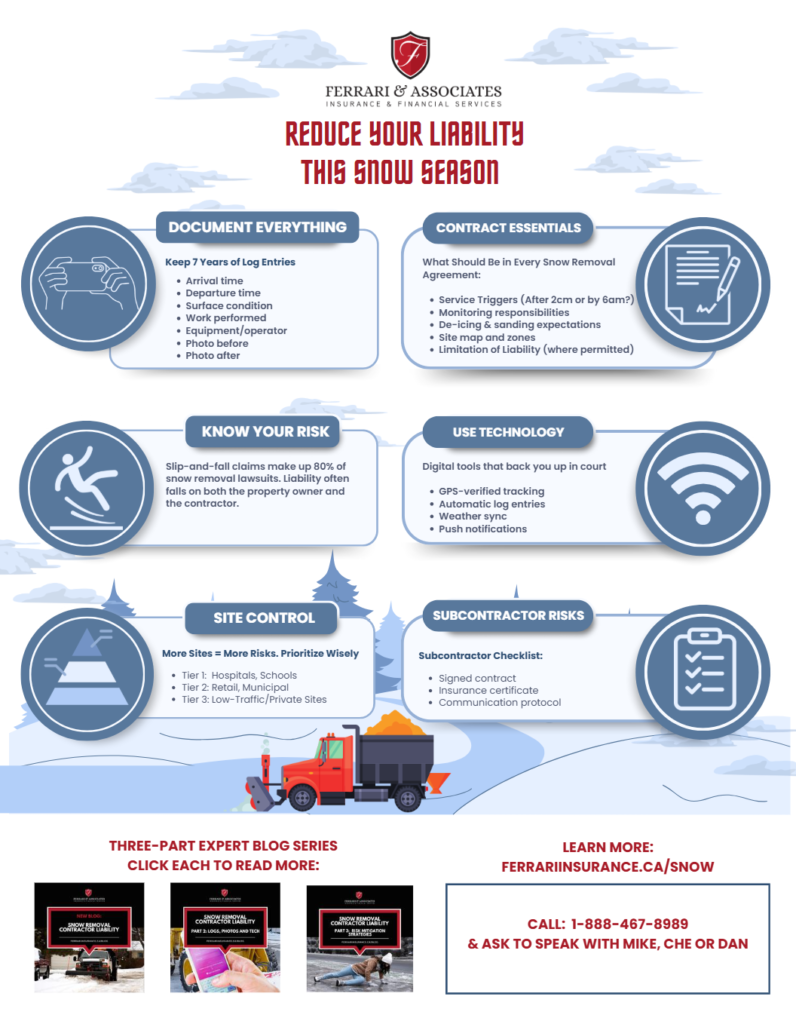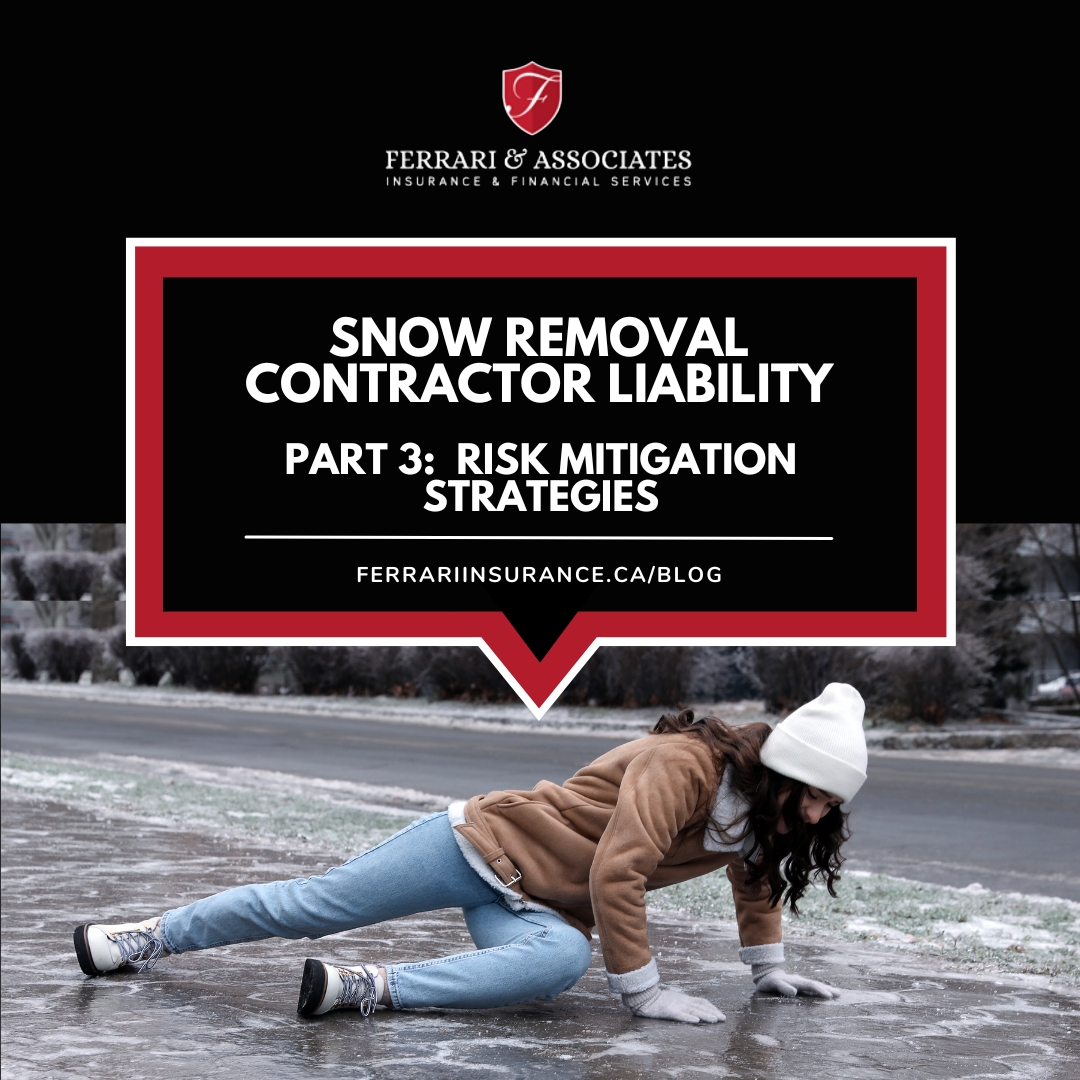Proactive risk strategies for snow removal contractors involve implementing strategic practices that address operational behaviors, site management, and client communications to reduce liability before issues arise. “Insurance is a critical component of a snow contractor’s risk plan, but it’s definitely not a shield for poor practices” Partner and VP of Construction Mike DiPinto says. This is final article in our three-part expert blog series for snow removal contractors. The first article provides an overview of the liability exposures contractors face during the winter months. Our second article explains the importance of logs, photos and using tech tools.
This article addresses how insurers are looking beyond premium payments and assessing contractor risk profiles based on operational behaviour. Our commercial insurance experts and Partners, Mike Di Pinto, Che Guerrera and Daniel Morra believe that to truly protect a snow removal business, it’s essential for contractors to adopt a proactive approach and anticipate risks before they escalate.
Risk Strategies for Snow Removal Contractors – Site Control and Priority Mapping
“Establishing a comprehensive site control plan is essential for reducing accidents and liability” says Partner Daniel Morra. “Contractors should develop and implement a site-specific priority mapping system, categorizing locations into high, medium, and low risk based on factors like pedestrian traffic, historical claims, and importance to the client.” Proper prioritization allows for more effective resource allocation, staff training, and timely interventions. For instance, high-traffic school zones or busy downtown crosswalks should be serviced first and with heightened caution.
Implementing clear documentation procedures is equally important. In our second article, Partner Che Guerrera said “your smartphone is one of your most powerful risk management tool. Before-and-after photos, time-stamped and geotagged, have resolved more than a few claims in favour of our clients.”
In this article, Che adds “record when your sites are serviced, the conditions encountered, and any challenges or incidents. This not only helps in accountability but also provides valuable evidence should a dispute arise.” Regular site audits and real-time communication tools enable contractors to promptly address emerging hazards, thereby mitigating potential liabilities.
A lesson from Surrey, British Columbia, underscores this point: a local contractor lost a municipal contract after failing to document site servicing, resulting in a lawsuit following a pedestrian fall. This case demonstrates that site control isn’t just about safety; it’s about verification, compliance, and protecting your reputation.
Risk Strategies for Snow Removal Contractors – Vetting Third-Party Subcontractors
Third-party subcontractors add an additional layer of risk. “Most contractors rely on subcontractors to manage workload, but this dependency should not be assumed to absolve responsibility” explains Partner and VP of Construction, Mike Di Pinto. “Contractors need to conduct thorough due diligence on subcontractors’ safety records and insurance coverage before engaging them.” Contracts should explicitly define responsibilities, expectations, and insurance requirements, including hold-harmless agreements and step-by-step documentation protocols.
Effective communication is key. Di Pinto adds “regular check-ins, shared digital logs, and incident reporting protocols help ensure subcontractors adhere to safety standards. As Partner Daniel Morra highlights, “assuming your subcontractor’s coverage will handle liabilities is a dangerous gamble. If your name is on the contract, liability remains with you until proven otherwise.” By maintaining control and oversight, contractors can prevent gaps that might lead to costly litigation.
Risk Strategies for Snow Removal Contractors – Client Education
Often overlooked but equally important is client education. Clients may underestimate the importance of timely service or assume contractors handle all liabilities independently. Proactively communicating expectations, limitations, and the contractor’s responsibilities helps set boundaries and prevent misunderstandings.
Ferrari & Associates advocates for incorporating disclaimers and educational materials into contracts and communication. Documenting client approvals, especially when they reject recommended services or timing adjustments, like the Halifax contractor who avoided litigation by preserving email records with their client rejecting overnight de-icing, can be invaluable. Such records serve as proof that the client was aware of potential risks and agreed to, or rejected specific service parameters.
Risk Mitigation Strategies for Snow Removal Contractors – Embracing Technology and Continuous Improvement
As explained in our second article, modern digital tools can elevate risk management. Mobile apps facilitate real-time documentation, GPS tracking ensures timely service verification, and incident reporting software streamlines communication. Regular safety training, updates on best practices, and a culture of accountability foster proactive risk mitigation.
Reducing liability exposure as a snow removal contractor isn’t just about playing defence; it’s about building a resilient, well-documented business capable of withstanding the unexpected. Risk Strategies for Snow Removal Contractors involve diligent site control, clear communication with clients and subcontractors, and leveraging technology to enhance oversight.
Work closely with insurance experts like Mike Di Pinto, Daniel Morra, and Che Guerrera at Ferrari & Associates. They provide tailored contract reviews, insurance solutions aligned with your operations, and practical advice on documentation strategies. As the snow season approaches, now is the ideal time to assess your risk management practices, invest in training, and adopt innovative tools to safeguard your business. By doing so, you position yourself not just to survive the season but to thrive through responsible, proactive operations that stand up to scrutiny and protect your reputation.


